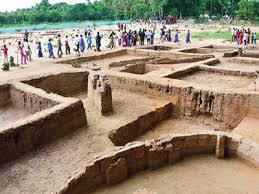
Skeletal remains of a child were excavated from Konthagai village, located around 2 km from Keeladi. It is believed to be a burial site, part of the sixth phase of ongoing excavations in the ancient site of Keeladi.
Daily Current Affairs Quiz 2020
Key-Points
The skeleton was found buried between two terracotta urns that were also found on the same day. It was 75 cm in height and was found 0.5 m below surface level.
Excavations are currently taking place at Keeladi, Konthagai, Manalur and Agaram villages in Sivaganga district. Konthagai village, located around 2 km from Keeladi, is believed to be a burial site.
Two other skeletal remains of adults were found at Konthagai during this phase. A total of 15 urns have been found till date.
A gold coin that is said to have been used extensively in the 17th century AD, some shells and pots, have also been found during the excavation, in all four sites.
Keeladi excavation site is a Sangam period settlement that is being excavated by the Archaeological Survey of India and the Tamil Nadu Archaeology Department.
The settlement lies on the bank of the Vaigai River. This site is located 12 km southeast of Madurai in Tamil Nadu, near the town of Keeladi in Sivagangai district. This is a large-scale excavation carried out in Tamil Nadu after the Adichanallur archaeological site.
This site is estimated to be from the period between 5th century BCE and 3rd century CE.





